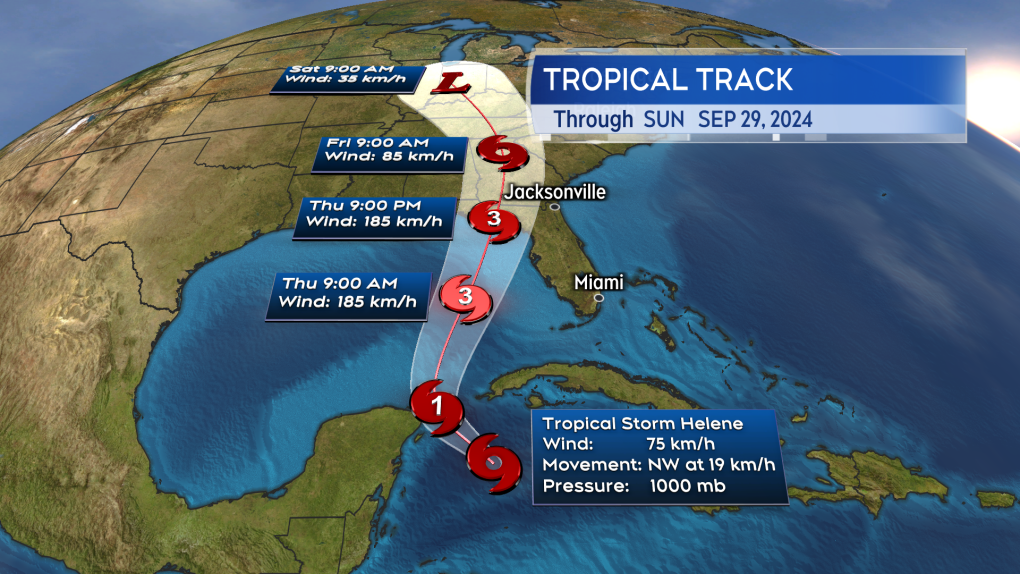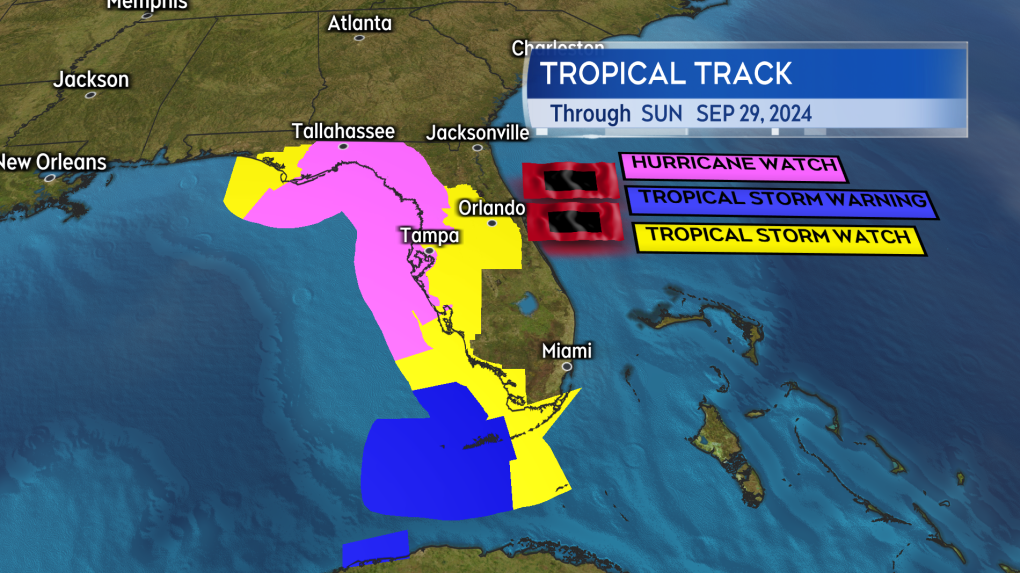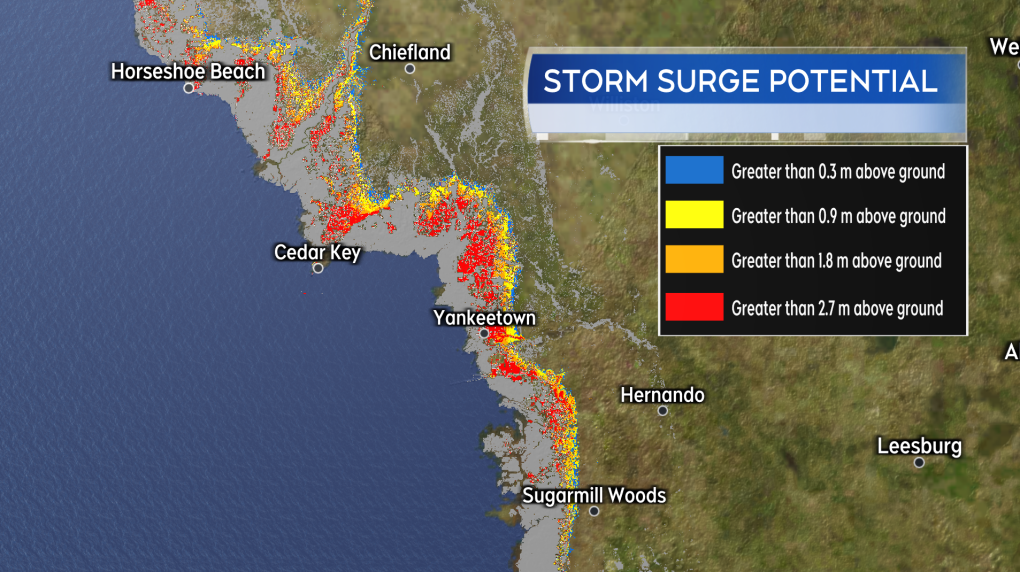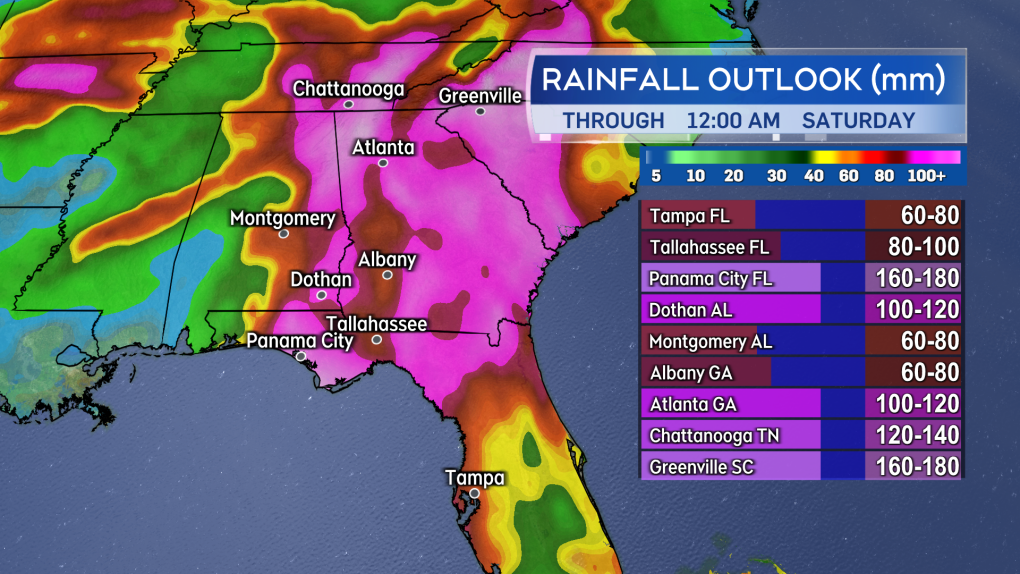Tropical Storm Helene forms, threatens Florida as a possible major hurricane
The eighth named storm of the 2024 Atlantic hurricane season has developed. Tropical Storm Helene is exiting the western Caribbean and moving into the Gulf of Mexico.
Rapid strengthening
Helene was declared a tropical storm on Tuesday after a hurricane hunter flight measured peak winds of 96 km/h near the centre of the storm.
The National Hurricane Center of the United States notes “significant strengthening is anticipated” over the next 48 hours. The agency’s forecast brings the storm up to a category-three hurricane in intensity by Thursday morning before an expected landfall later that day on the Florida panhandle. Category-three hurricanes are capable of causing structural damage to building via wind and storm surge, uprooting a large number of trees, and creating utility outages that can take several weeks to recover from.
Factors contributing to the increase in strength of the storm include very warm waters in the Gulf of Mexico. Sea surface temperatures are near 31 degrees over the expected path of the storm. Additionally there is very little wind of the Gulf of Mexico at the moment, which should allow the storm to have a very organized structure to gain and maintain strength.
 Helene is forecast to move into the Gulf of Mexico and intensify to a category-three hurricane before making landfall in Florida. (Source: CTV News Atlantic)
Helene is forecast to move into the Gulf of Mexico and intensify to a category-three hurricane before making landfall in Florida. (Source: CTV News Atlantic)
Hurricane watches issued
The National Hurricane Center has issued a number of hurricane and tropical storm alerts stretching from Cuba and the tip of the Yucatan Peninsula of Mexico to Florida.
As of noon on Tuesday, a Hurricane Watch is in effect for:
- Cabo Catoche to Tulum, Mexico
- Cuban province of Pinar del Rio
- Englewood to Indian Pass
- Tampa Bay
A Tropical Storm Warning is in effect for:
- Dry Tortugas
- Lower Florida Keys west of the Seven Mile Bridge
- Grand Cayman
- Rio Lagartos to Tulum, Mexico
- Cuban provinces of Artemisa, Pinar del Rio, and the Isle of Youth
A Tropical Storm Watch is in effect for:
- Middle Florida Keys from the Seven Mile Bridge to the Channel 5 Bridge
- Flamingo to south of Englewood
- West of Indian Pass to Walton Bay County line
The National Weather Service offices of Florida have issued a Hurricane Watch stretching from near Tallahassee on the panhandle to south of Tampa Bay. A Tropical Storm Watch extending inland to Orlando. A Tropical Storm Warning means tropical storm conditions are expected within 36 hours. A Tropical Storm Watch means tropical storm conditions are possible within 48 hours. A Hurricane Watch means that hurricane conditions are possible within 48 hours.
Both weather agencies remind the public to adhere to official guidance on hazards and safety.
 Watches and warnings issued by weather agencies in the US ahead of the arrival of Helene. (Source: CTV News Atlantic)
Watches and warnings issued by weather agencies in the US ahead of the arrival of Helene. (Source: CTV News Atlantic)
Storm surge and heavy inland rain hazards
Due to the approach and intensity of the storm, extensive storm surge is possible on parts of the western Florida coastline. Some of the most extensive surge forecast for the area begins near Crystal River, FL, and extends north along the coast to near St. Marks, FL. In some areas, the storm surge may bring water levels to more than 2.7 metres (nine feet) above the ground.
 Preliminary storm surge potential for parts of Gulf of Mexico coastline of Florida. (Source: CTV News Atlantic)
Preliminary storm surge potential for parts of Gulf of Mexico coastline of Florida. (Source: CTV News Atlantic)
Weather model guidance for the storm indicates rain totals that could range from 100-to-200 mm are a risk for northern Florida, eastern Alabama and Tennessee, as well as western parts of Georgia, South Carolina, and North Carolina. That amount of rain could bring a considerable amount of flash and urban flooding.
 Rain totals of well in excess of 100 mm are indicated as a risk for parts of the southeastern United States. (Source: CTV News Atlantic)
Rain totals of well in excess of 100 mm are indicated as a risk for parts of the southeastern United States. (Source: CTV News Atlantic)
No major impacts from the storm are expected in Canada. Some of the last rain associated with the storm could brush into southern Ontario this upcoming weekend. There is considerable uncertainty in that though as it will largely depend on what happens with the system once it is inland in the southeastern United States.
CTVNews.ca Top Stories

DEVELOPING 'A carbon tax election': MPs debate Conservative non-confidence motion in Liberal government
MPs in the House of Commons are debating the Conservatives’ non-confidence motion today, with Conservative Leader Pierre Poilievre calling for 'a carbon tax election,' and a return to what he called 'the Canadian promise' in a 20-minute speech.
EXCLUSIVE Image released of mysterious object shot down over Yukon in 2023
An image of the unidentified object shot down over Canada's Yukon territory in February 2023 has been obtained by CTVNews.ca.
Couple in Sault Ste. Marie, Ont., awarded more than $500K for enduring life with hellish neighbour
We've all had neighbours we didn't like, but two people from Sault Ste. Marie have been awarded more than half a million dollars for the 'extreme' behaviour of the people who lived next to them.
Police arrest five people in Spain over fake Brad Pitt scam after two women lost US$362,000
Police in Spain have arrested five people accused of scamming two women out of 325,000 euros (US$362,000) by pretending to be Hollywood star Brad Pitt online.
Health Canada approves Pfizer-BioNTech's updated COVID-19 vaccine
Health Canada has approved Pfizer-BioNTech's updated COVID-19 vaccine that protects against one of the most recently circulating variants of the virus.
Canadians in Lebanon told to get out while flights available, don't wait for government evacuation
The federal government is advising Canadians in Lebanon to leave now while commercial flights are available, saying, 'Canada is not currently offering assisted departures or evacuations.'
Pro Football Hall of Fame quarterback Brett Favre has Parkinson's
Pro Football Hall of Fame quarterback Brett Favre revealed Tuesday at a hearing on federal welfare reform that he has been diagnosed with Parkinson's disease.
Ontario woman seen in viral video of Porsche theft now facing more charges
An 18-year-old woman who allegedly stole a Porsche and then ran over its owner in a caught-on-video incident in Mississauga earlier this month is now facing auto theft charges in Toronto.
Bank of Canada says it's reasonable to expect more rate cuts
Given the continued progress the Bank of Canada has made in bringing inflation back down to the 2 per cent target, it is reasonable to expect more rate cuts, Governor Tiff Macklem said on Tuesday.


































